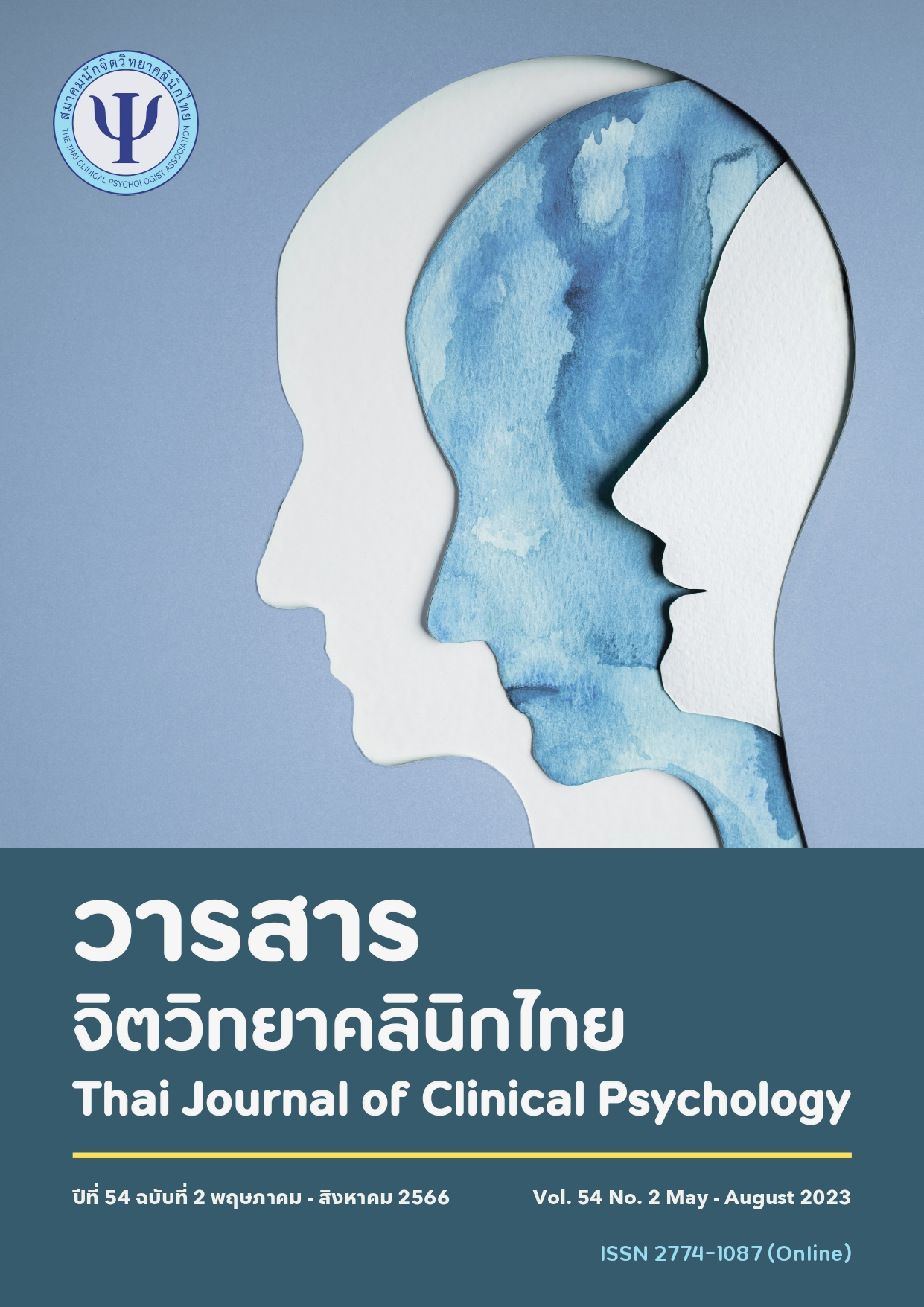การพัฒนาแอปพลิเคชันฝึกเพ่งความสนใจจดจ่อและการจินตภาพด้วยภาพสำหรับนักเรียนมัธยมศึกษาตอนต้น
Main Article Content
บทคัดย่อ
วัตถุประสงค์ เพื่อทดสอบประสิทธิผลของแอปพลิเคชันฝึกเพ่งความสนใจจดจ่อและการจินตภาพด้วยภาพในนักเรียนมัธยมศึกษาตอนต้น วัสดุและวิธีการ กลุ่มตัวอย่างเป็นนักเรียนชั้นมัธยมศึกษาปีที่ 3 ที่ไม่มีความบกพร่องทางการเรียนรู้และการมองเห็น สมัครใจเข้าร่วมการทดลอง จำนวน 60 คน จัดเข้ากลุ่มโดยจับคู่คะแนนจากแบบทดสอบการจินตภาพด้วยภาพ แบ่งออกเป็น 3 กลุ่ม กลุ่มละ 20 คนคือ กลุ่มทดลอง 1 เข้ารับโปรแกรมฝึกเพ่งความสนใจจดจ่อและการจินตภาพด้วยภาพร่วมกับแอปพลิเคชันฝึกเพ่งความสนใจจดจ่อและการจินตภาพด้วยภาพ จำนวน 8 ครั้ง กลุ่มทดลอง 2 ใช้แอปพลิเคชันฝึกเพ่งความสนใจจดจ่อและการจินตภาพด้วยภาพด้วยตนเอง จำนวน 8 ครั้ง และกลุ่มควบคุมโดยเข้าเรียนตามปกติ วัดทักษะการจินตภาพด้วยภาพ 3 ระยะ คือ ก่อนทดลอง หลังทดลองทันทีและระยะติดตามผล 2 สัปดาห์ วิเคราะห์ความแปรปรวนแบบวัดซ้ำประเภทหนึ่งตัวแปรระหว่างกลุ่มและหนึ่งตัวแปรภายในกลุ่ม และเปรียบเทียบเป็นรายคู่ด้วยวิธี Bonferroni ผลการศึกษา กลุ่มทดลอง 1 มีคะแนนเฉลี่ยการจินตภาพด้วยภาพหลังการทดลองและระยะติดตามผล สูงกว่าก่อนการทดลอง และสูงกว่ากลุ่มควบคุม อย่างมีนัยสำคัญทางสถิติที่ระดับ .05 กลุ่มทดลอง 2 มีผลการทดลองสอดคล้องกับกลุ่มที่ 1 ยกเว้นระยะติดตามผลคะแนนไม่แตกต่างกัน สรุป โปรแกรมฝึกเพ่งความสนใจจดจ่อและการจินตภาพด้วยภาพร่วมกับแอปพลิเคชันฝึกเพ่งความสนใจจดจ่อและการจินตภาพด้วยภาพเพิ่มการจินตภาพด้วยภาพได้ดีกว่าการใช้แอปพลิเคชันเพียงอย่างเดียวและกลุ่มควบคุม
Article Details

This work is licensed under a Creative Commons Attribution-NonCommercial-NoDerivatives 4.0 International License.
เรื่องที่ลงตีพิมพ์ในวารสารจิตวิทยาคลินิกแล้วถือเป็นลิขสิทธิ์การเผยแพร่โดยวารสารจิตวิทยาคลินิกแต่เพียงผู้เดียว การตีพิมพ์หรือเผยแพร่ซ้ำในที่อื่นต้องได้รับอนุญาตจากกองบรรณาธิการวารสารฯ
References
Aomsinsomboon, R. (2016). Mobile Application Development Studies: The Case of Public Transportation Service [Master’s thesis, Thammasat University]. Thammasat University Library. http://ethesisarchive.library.tu.ac.th/thesis/2016/TU_2016_5823036024_5598_6288.pdf (in Thai).
Clarke, J., & Draper, S. (2020). Intermittent mindfulness practice can be beneficial, and daily practice can be harmful. An in depth, mixed methods study of the “Calm” app's (mostly positive) effects. Internet interventions, 19, 100293.
Diamond, A. (2013). Executive functions. Annual review of psychology, 2013(64),135-168. https://doi.org/10.1146/annurev-psych-113011-143750
Galotti, K. M. (2014). Cognitive psychology. California.
Haenjohn. J. (2016). The effects of mindfulness on emotional competencies and well-being of undergraduate students. Journal of education, Burapha University, 27(2), 208-222.
Haenjohn, J. (2019). Cognitive Psychology. (2rd Edition). Grandpoint.
Hasenkamp, W., Wilson-Mendenhall, C. D., Duncan, E., & Barsalou, L. W. (2012). Mind wandering and attention during focused meditation: a fine-grained temporal analysis of fluctuating cognitive states. Neuroimage, 59(1),750-760.
Luft, C. D. B., Zioga, I., Banissy, M. J., & Bhattacharya, J. (2019). Spontaneous visual imagery during meditation for creating visual art: an EEG and brain stimulation case study. Frontiers in psychology, 10.
Mahmood, L., Hopthrow, T., & Randsley de Moura, G. (2016). A moment of mindfulness: Computer-mediated mindfulness practice increases state mindfulness. PLoS One, 11(4), e0153923.
NCS Pearson, I. (2016). Naglieri Nonverbal Abilities Test.
Pitipornwiwat, M. (2018, n.d.). 21st Century Skills: When old skills not enough anymore. Medium. Retrieved October 30, 2019, from https://medium.com/base-the-business-playhouse/ 21st-century-skill/ (in Thai).
Sangsuphan, K. (2018, n.d.). Driving and Developing the Education System to Support the development of the Eastern Economic Corridor. Eastern Economic Corridor. Retrieved November 11, 2019, from https://www.eeco.or.th/ (in Thai).
Tomasino, B., & Fabbro, F. (2016). Increases in the right dorsolateral prefrontal cortex and decreases the rostral prefrontal cortex activation after-8 weeks of focused attention based mindfulness meditation. Brain and cognition, 102, 46-54.
Tsai, M.-H. (2016). Attentional orienting and executive control are affected by different types of meditation practice. Consciousness and cognition, 46, 110-126.
Veraksa, N., Gavrilova, M., & Veraksa, A. (2022). “Complete the Drawing!”: The Relationship between Imagination and Executive Functions in Children. Education Sciences, 12(2), 103.

